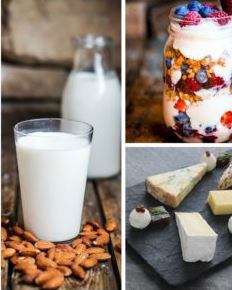My grandmother would be confused about the controversy surrounding milk and other dairy products. Twice a day she went out to her barn and milked Bessie, never forgetting to give a quick spray of milk to the cat wrapping itself around her ankles. She then magically turned that liquid gold into butter, cheese and cottage cheese, to the delight of my grandfather and dozens of hungry grandkids. While this sounds like a fairy tale, it is a story that played out across the country only a short generation ago.
 Politics, finances, rural repopulation, big agriculture and a changing nutrition climate have made the story more complicated. But that’s all for another essay, another time. For now, let’s explore the attributes of, and alternatives to, this simple food group.
Politics, finances, rural repopulation, big agriculture and a changing nutrition climate have made the story more complicated. But that’s all for another essay, another time. For now, let’s explore the attributes of, and alternatives to, this simple food group.
Benefits and serving recommendations: Milk and other dairy products provide complete proteins, calcium, vitamin D, vitamin A, B vitamins, phosphorus, magnesium and potassium, making it a bountiful contributor to bone, tooth, muscle, skin and heart health. Many nutrition experts recommend 2-3 servings per day.
Milk substitutes: If you do not or cannot drink milk, many of its nutrients may be found in nondairy milk substitutes, as they are often called. These include soy, almond, macadamia, pea and coconut milk. Be sure to read the label to make sure you are getting protein, calcium and vitamin D. Some milk substitutes, such as rice milk, may be poor sources of these.
Other sources of milk nutrients: Calcium is found in sardines and canned salmon with bones, fortified orange juice and cereal, tofu and greens such as kale, turnip greens and bok choi. Vitamin D sources include salmon, swordfish, tuna and egg yolks as well as fortified juice and cereals. Talk to your doctor or dietitian if you think you might need a supplement.
If you are lactose intolerant: Lactose intolerance, also referred to as lactose malabsorption and lactase insufficiency, occurs when the body does not have enough of the lactase enzyme to break down the milk sugar lactose. This results in stomach aches, nausea, bloating, gas and sometimes diarrhea. Individuals with these symptoms should avoid milk and milk products until the digestive tract is healed, then slowly reintroduce small portions, such as ½ cup of milk or yogurt. Yogurt and hard cheese are often well tolerated.
If you have a milk allergy: True milk allergies are much less common than lactose intolerance, and most likely to occur in children; it is estimated that 80 percent of children outgrow their milk allergy by age 16. Symptoms may include hives and impaired breathing, making it a serious condition that requires avoidance of milk and foods containing milk products. Work with your doctor to determine if you have a milk allergy or have outgrown it.
Whether you choose to celebrate the attributes of dairy this month, or lean toward alternative sources of nutrients, I — and my grandmother — would encourage you to make the choices that are best for you.
Melissa Wdowik, PhD, RDN, FAND, is an assistant professor at Colorado State University in the Department of Food Science and Human Nutrition, and director of the Kendall Reagan Nutrition Center.





